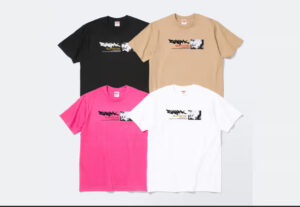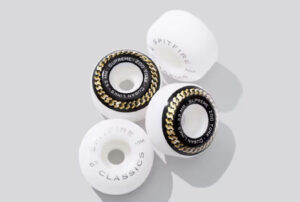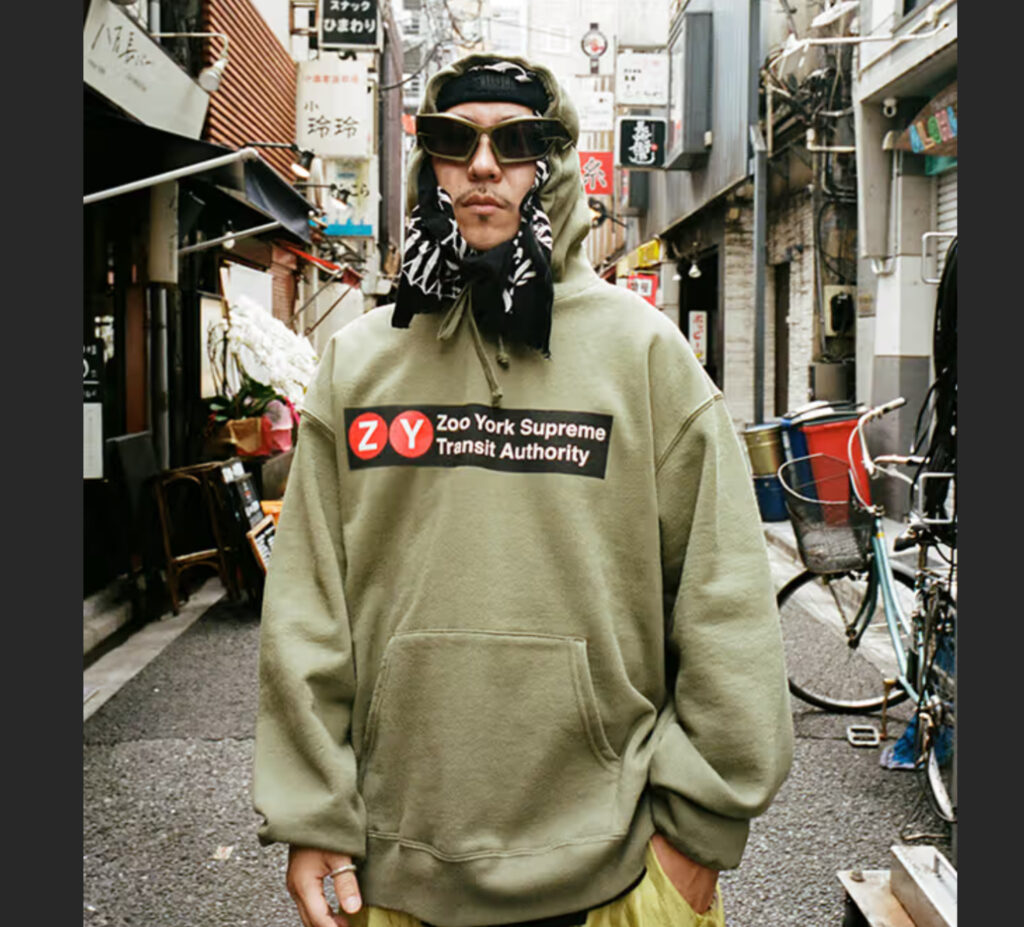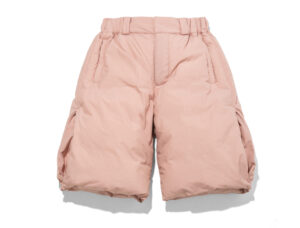

New York is not gentle. It is not pastel. It doesn’t ask you to like it; it dares you to survive it. And for those who did—who carved lines through SoHo sidewalks and manualed across brownstone railings—Zoo York was a badge of allegiance. Two decades before Instagram aestheticized grit, Zoo York distilled it. And now, in a landmark Spring 2025 connection, Supreme resurrects that signature DNA, honoring the street-smart, spray-can-smeared, boom-bap-beating heart of East Coast skateboarding with a release that revisits the holy relic: The Zoo York Mixtape (1997). The result is more than just fashion nostalgia. It’s a reprint of the city’s rawest lyric.
ORIGIN STORIES: THE NEW YORK SKATE RENAISSANCE
When Zoo York was founded in 1993, it wasn’t just creating skateboards; it was preserving the soul of a scene. Skateboarding in NYC was nothing like its West Coast counterpart. There were no backyard pools or endless summer parks. The East Coast scene was born in alleyways, train stations, and busted sidewalks. It was improvisational, adversarial, and deeply intertwined with graffiti crews and underground rap.
Zoo York emerged from that milieu with a mission: to amplify the city’s sound, rhythm, and velocity through skate culture. It fused the energy of Zoo Crew graffiti legends, the heartbeat of the five boroughs, and the DIY ethos of skaters who didn’t need pristine spots to shred. Instead of SoCal’s polished kickflips on manicured marble, there were noseslides over cellar doors and ledges dented by city grime.
By the time The Zoo York Mixtape dropped in 1997—filmed by RB Umali and projected at the New York Underground Film Festival—it felt less like a skate video and more like a cultural exhale. It featured skaters like Harold Hunter, Peter Bici, Robbie Gangemi, and Jefferson Pang flowing through NYC like vinyl through a turntable. Interspersed between gritty 16mm skate footage were freestyles from Method Man, Busta Rhymes, Fat Joe, and Ghostface Killah, sourced from the immortal Stretch and Bobbito radio show. The result was the crystallization of East Coast ethos.
Supreme, also a New York original, was born the year after Zoo York. From its Lafayette Street shop to its status as global streetwear titan, Supreme mirrored Zoo’s energy: uncompromising, unglossed, and authentically downtown. In Spring 2025, the two finally join forces to canonize the city that made them.
MIXTAPE AS BLUEPRINT
At the center of this mixture is The Zoo York Mixtape—not merely referenced, but embedded into the very fiber of the release. This was the Bible for a generation of East Coast skaters, a black-and-white zine-on-film that glorified crusty spots and corner-store aesthetics. It was a visual cipher where graffiti tags, hip-hop bars, and frontside flips danced in grayscale harmony.
Supreme’s 2025 collection smartly invokes the mixtape as both title and method. Like a cassette tape cobbled together from your cousin’s bootlegs and a lost Dilla cut, the pieces mix mediums, genres, and materials. Here, clothing is collage. Every hoodie and jersey feels like a timestamp, every T-shirt like a sleeve insert. It’s not just fashion—it’s a wearable VHS.
THE COLLECTION: MATERIALISING MEMORY
Soccer Jersey & Shorts
The collection opens with a surprise: the Soccer Jersey and Shorts, retrofitted with graffiti tags and oversized mesh panels. While soccerwear is a staple in Supreme’s design canon, this rendition is unmistakably Zoo. The typeface is raw, lettered like a throw-up on the D train. The jersey’s vertical striping nods to both 1990s Euro kits and the pinstriped metal gates of Bronx storefronts. The shorts follow suit—baggy, breathable, built for skating in humidity thick as steam off the FDR.
Hooded Sweatshirt
The hoodie is a battlefield canvas. Supreme’s heavyweight fleece is layered with distressed Zoo York logos: some screen printed, some embroidered, some stitched over like they’ve been bombed and re-tagged. The silhouette is classic Supreme—boxy, warm, and slouching—but with layered elements that echo old mixtape covers: dense, nonlinear, visually noisy. It wears like a wall in Alphabet City.
Baggy Jean
It wouldn’t be a 1990s revival without the Baggy Jean. This piece might be the most literal homage, echoing the deep-cuffed, paint-stained denim that defined downtown skaters from Union Square to Brooklyn Banks. Rendered in a heavy indigo wash with contrast stitching and a Zoo York x Supreme patch above the back pocket, it’s pure East Coast function: armor for ledges, rail slides, and cold stoops.
Camp Cap & Beanie
The Camp Cap, a Supreme mainstay, receives a five-panel refresh stamped with collaborative logos. Muted tones—blacks, olives, concrete grays—recall old bricks and faded murals. The Beanie comes in slouched, wool-blend ribbing, raw like an unfinished bar. Each logo is rendered like a shout-out, not a billboard.
T-Shirts
The tees are screen-printed to replicate the zine-like feel of the 1997 mixtape. One features Harold Hunter, mid-push, blurred into motion like a ghost of Tompkins Square. Another places a quote from a Stretch & Bobbito broadcast over graffiti backdrops. Fonts clash like freestyles over static. It’s less merch, more ephemera.
Skateboard Deck & Spitfire Wheels
The pièce de résistance: a Zoo York x Supreme deck, dipped in mixtape visuals. The underside is a freeze frame from Umali’s original film, with type that bleeds like xerox ink. Spitfire® Classic Wheels, co-branded and ready to take beatings from asphalt, round out the kit—practical tools that also double as heirlooms.
THE SOUND OF SKATING
What The Zoo York Mixtape offered was rhythm—not just from hip-hop but from how skaters rode the city. You could almost hear the tail cracks on marble, the roll-ups to pyramid ledges, the pause before a pop. Supreme’s collaboration doesn’t just speak to this—it listens. Every stitch and hem hums with that rhythm.
By embedding quotes and clips from Stretch Armstrong and Bobbito Garcia’s radio show—a 1990s sanctuary for unsigned, unfiltered rap—this collection grounds itself in the unrepeatable moments when hip-hop was still raw, regional, and reverent. That radio show wasn’t just about beats; it was a cipher, a place of proving and possibility. So was the skatepark.
PACKAGING, RELEASE & PRESERVATION
The Supreme x Zoo York Spring 2025 drop is not just a rollout. It’s a revival. Set to release on June 19 in the U.S. and June 21 across Asia, the pieces are expected to sell out faster than a Busta freestyle on cassette dub.
The release is accompanied by a special Mixtape Redux short film, directed by RB Umali and scored with archival clips from the Stretch and Bobbito show. The film will screen at select Supreme flagships before appearing online—a tribute to the way skate videos used to travel: hand-to-hand, tape-to-tape, memory-to-memory.
Supreme’s lookbook leans into this nostalgia. Shot in black-and-white across Lower Manhattan and Queensbridge, it features skaters new and old—some Zoo York originals, others born years after the mixtape first dropped—all threading kickflips through subway staircases and weaving switch flips across housing project courtyards. The sound? Pure static and snare.
WHY THIS MATTERS NOW
In a world where skateboarding is now Olympic and hip-hop is algorithmic, there’s something sacred in this act of remembrance. Supreme x Zoo York isn’t trying to monetize memory—it’s trying to reactivate it.
This isn’t about retro for retro’s sake. It’s about reminding a new generation that before the boutiques, before the apps, before the metrics, there was the mixtape. There was the cracked pavement. There was the radio show you had to tune in to at 2 a.m. There was a city too hard to imitate and too real to market.
Supreme and Zoo York have nothing to prove—this collab is proof.
The Supreme x Zoo York Spring 2025 collection is not about trend. It is about torch. It passes something forward: the cadence of city skating, the loops of late-night radio, the blur of graffiti in motion. It makes you remember when skating wasn’t about sponsorships but survival, when hip-hop didn’t stream—it beamed.
It’s a mixtape you can wear. A city you can carry.
And like the best freestyles, it lives in memory—but it hits hardest when played loud again.
No comments yet.









